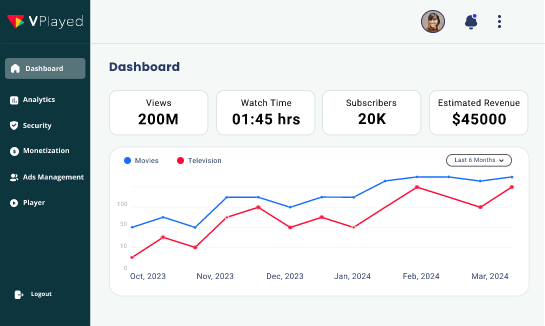Best ways to distribute your video content with Pay-per-view!

Once a staple in cable television, PPV has broken all the odds in marking its presence into the OTT ecosystem as not all viewers want to have a long-term commitment to a video streaming services.
Though it might seem a very recent pricing technique, the inception of PPV dates back to the late 1940s.
Television channels picked up the trend decades later which now is widely adopted by content owners and publishers into the digital media for all the good reasons.
Be it on-demand or live videos, the pay-per-view or the TVOD business model has taken the video streaming industry by storm where YouTube TV, Dazn, and Sky Sports are classic examples.
Table of Contents
The PPV style of streaming, “a futuristic road to OTT monetization”
To put it simply, businesses that adopt the PPV model charge their viewers only for a particular piece of content, unlike subscription SVOD business pricing that offers access to the entire library for a recurring fee, usually monthly or annually.
The feasibility to either rent a piece of content for a specific time frame or own it indefinitely for viewing on the online video platform has enticed audiences into making a one-time payment for the offering that interests them.
In fact, the numbers projected in regard to the pay-per-view model are pretty impressive with the market revenue to hit a whopping $13,538 million by 2026.
This indeed has caught the attention of several content owners, publishers, and live broadcasters across niches to step foot or expand their offerings in newer dimensions like that of this one.
A simple & straightforward business model
By placing premium content behind a paywall, streaming services easily put audiences in a spot that lets them decide if they want to pay for it or not.
Hence, monetizing via PPV is not only simple but also lets OTT platforms garner good profits when their offering is unique, in demand, and holds great value among niche audiences.
Particularly in verticals like sports, entertainment, music, and live streaming, where the scope for people willing to pay is comparatively high, content owners can make the best use of this method of video monetization since the user penetration in the TVOD landscape is set to hit 11.4% by 2026.
How to price your content with PPV?
Pay-per-view is a rather simple revenue model but can be highly rewarding when structured right.
It is the flexibility, convenience, and complete control platform owners possess over their money-making decisions that have made PPV one of the fail-proof OTT monetization strategies in recent times.
However, the following attributes should be factored into the picture before you are steadfast to incorporating the PPV process of money-making.
-
Video Rental or Pay-Per-Download
You have two options, to begin with, either rent out your video for a particular window of time, say 2 days, or let them own the content indefinitely for a fixed fee. This of course depends on a number of factors as follows.
-
Length of Your Video
The length of the video is an extremely crucial part of pricing and access. A three-hour-long movie would definitely demand more access time than a video of a shorter duration.
-
Target Geography
Before settling upon a fee, thorough market research would help infer how much the audiences in the countries you target are willing to pay. Excruciatingly high prices for geographies that don’t prefer PPV will reap no benefits.
-
Production Costs
Often ignored, operating costs should be a part of the pricing strategy. Behind-the-screen spendings make up a large portion of your overall investment and ought to be considered before pricing your on-demand/ live content.
-
Revenue Goals
Long-term streaming goals differ with each business. However, it is vital to forecast a definite number so that your video rentals can be priced to match the pace.
-
Competitor Pricing
Competitor pricing is a key requirement that should be taken into account to offer content at a fee that seems great value for money.
And of course, it doesn’t quite end here.
There are a number of other practical considerations that content owners might have to look into before pricing their content.
The Perks of Paywalling Your Content Behind PPV
“A pricing mechanism that doesn’t pressurize audiences to sign up is an attractive USP for businesses to sell their content”
Ease of business operability is truly one of the major reasons businesses instill PPV as a means of pricing.
In other words, the billing is uncomplicated; video performance can effortlessly be gauged since audiences pay only for the content they want to consume, which gives further insights into what works best for your target market.
Similarly, an ad-free environment with lower barriers that doesn’t urge viewers to sign-up also makes audiences choose PPV services over its peers in the market.
To wrap up,
Considering the market demand that is reaching unprecedented heights each passing day, and the likelihood of audiences to consume premium content without actually having to give a long-term commitment to, the pay-per-view style of pricing is a comfortable model for businesses to adopt.
There is typically less churn, the retention rate is high, and also drives a great volume of organic traffic, provided you own premium content paywalled by PPV.
In essence, the future of transactional pricing is beaming as the average revenue per user is currently $13.5 and is estimated to climb to $15.1 by 2026, in addition to pandemic-led lockdowns that will further propel viewers to look for remote/ live offerings.


